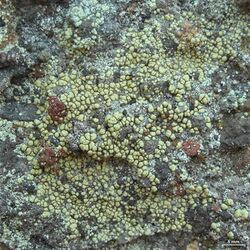Biology:Lecanora polytropa
| Lecanora polytropa | |
|---|---|

| |
| Scientific classification | |
| Domain: | Eukaryota |
| Kingdom: | Fungi |
| Division: | Ascomycota |
| Class: | Lecanoromycetes |
| Order: | Lecanorales |
| Family: | Lecanoraceae |
| Genus: | Lecanora |
| Species: | L. polytropa
|
| Binomial name | |
| Lecanora polytropa (Ehrh.) Rabenh. (1845)
| |
| Synonyms | |
| |
Lecanora polytropa, commonly known as the granite-speck rim lichen, is a species of saxicolous lichen in the family Parmeliaceae. A small, inconspicuous species that grows in the cracks of rock surfaces, it has a cosmopolitan distribution and has been recorded on all continents, including Antarctica.
Taxonomy
It was originally described by German botanist Jakob Friedrich Ehrhart in 1796 as a species of Verrucaria.[1] Gottlob Ludwig Rabenhorst transferred it to the genus Lecanora in 1845.[2]
It is commonly known as the granite-speck rim lichen.[3]
Description
Lecanora polytropa has a scanty thallus, which sometimes resembles tiny pale yellowish areoles. The tiny, flat apothecia typically measure 0.3–0.9 mm in diameter and may be scattered or clustered together. They have a waxy texture and are yellow to pale orange, lacking pruina. The margins of the apothecia are smooth, not prominent, and tend to be lighter in colour than the central disc. Ascospores are ellipsoid and measure 8–15 by 5–7 μm.[3]
Habitat and distribution
Lecanora polytropa grows on siliceous rock, particularly granite. It prefers locations with full sun exposure. It is common on exposed granite boulders and outcrops throughout its range, although it may readily be missed due to its small size.[3] The lichen has a cosmopolitan distribution, and is known from all continents.[4] It is found in the maritime and continental Antarctic, including the Antarctic Peninsula, Queen Mary Land, and Victoria Land.[5]
In a study of the community structure of saxicolous lichens found on rock faces within a 4 kilometres (2.5 mi) radius of the Mount Tokachi volcano in Japan, researchers found that Lecanora polytropa thrived in the volcanic environment (close to the active fumarole) that was intolerable for many other species. Its tiny thalli can insert into the small depressions and cracks on the rock, helping it gain a foothold and begin surface colonisation even when faced with the weathering associated with high winds and storms.[6] Lecanora polytropa is also involved in the succession of lichens that appear on gravestones, and tends to maintain its presence long after its initial colonisation.[7] Lecanora polytropa was one of three lichens found growing at an altitude of 7,400 m (24,300 ft) in Makalu (Nepal)–the highest recorded elevation for lichen.[8]
Species interactions
Lecanora polytropa is a known host to the lichenicolous fungus species Carbonea aggregantula,[9][10][11][12][13] Carbonea supersparsa,[14][10][13] Carbonea vitellinaria,[12] Cercidospora epipolytropa,[11][12] Endococcus propinquus,[15] Lichenoconium lecanorae,[11][12] Muellerella erratica,[11][12] Muellerella lichenicola,[9] Muellerella pygmaea var. athallina[15] and Stigmidium squamariae.[12] Two additional species of Arthonia infecting this lichen, A. epipolytropa and A. subclemens, were described in 2023.[16]
Similar species
Lecanora polytropa may be confused with L. fuscobrunnea, which has larger apothecia (up to 1.6 mm wide) that are partially blackened to completely black, and may have a rudimentary stipe. In L. polytropa, the apothecia are always sessile and not blackened.[5]
See also
References
- ↑ Hoffmann, Georg Franz (1796). "Deutschlands Flora oder botanisches Taschenbuch. Zweyter Theil für das Jahr 1795." (in Latin). Cryptogamie: 196. https://www.biodiversitylibrary.org/page/52834033.
- ↑ Rabenhorst, Ludwig (1845) (in German). Deutschlands Kryptogamenflora. 2. E. Kummer. p. 37. https://books.google.com/books?id=oAwWAAAAYAAJ&pg=PA37.
- ↑ 3.0 3.1 3.2 Brodo, Irwin M.; Sharnoff, Sylvia Duran; Sharnoff, Stephen (2001). Lichens of North America. Yale University Press. p. 387. ISBN 978-0300082494.
- ↑ Nash, T.H.; Ryan, B.D.; Gries, C.; Bungartz, F. (2004). Lichen Flora of the Greater Sonoran Desert Region. 2. ISBN 978-0-9716759-1-9.
- ↑ 5.0 5.1 Smykla, Jerzy; Krzewicka, Beata; Wilk, Karina; Emslie, Steven D.; Śliwa, Lucyna (2011). "Additions to the lichen flora of Victoria Land, Antarctica". Polish Polar Research 32 (2): 123–138. doi:10.2478/v10183-011-0009-5. http://journals.pan.pl/Content/99493/PDF/10183_Volume32_Issue2_04_article.pdf.
- ↑ Shimizu, Akira (1994). "Community structure of lichens in the volcanic highlands of Mt. Tokachi, Hokkaido, Japan". Bryologist 107 (2): 141–151. doi:10.1639/0007-2745(2004)107[0141:CSOLIT2.0.CO;2].
- ↑ Hill, David Jackson (1994). "The succession of lichens on gravestones: a preliminary investigation". Cryptogamic Botany 4: 179–186. https://www.researchgate.net/publication/265519470.
- ↑ Scheidigger, Christoph (2021). "2.4. High alpine lichens". Life at Rock Surfaces: Challenged by Extreme Light, Temperature and Hydration Fluctuations. Life in Extreme Environments. 6. Berlin: Walter de Gruyter GmbH & Co KG. p. 163. doi:10.1515/9783110646467-006. ISBN 978-3-11-064646-7.
- ↑ 9.0 9.1 Alstrup, Vagn; Hansen, Eric Steen; Daniels, Fred J. A. (2000). "Lichenized, lichenicolous and other fungi from North and North-East Greenland". Folia Cryptogamica Estonica 37: 1–20. https://www.researchgate.net/publication/323812998.
- ↑ 10.0 10.1 Diederich, Paul (2003). "New species and new records of American lichenicolous fungi". Herzogia 16: 41–90. https://www.researchgate.net/publication/237730002.
- ↑ 11.0 11.1 11.2 11.3 Kukwa, Martin; Flakus, Adam (2009). "New or interesting records of lichenicolous fungi from Poland VII. Species mainly from Tatra Mountains". Herzogia 22: 191–211. https://blam-bl.de/images/Herzogia_22/Downloads/H22-Kukwa-Flakus.pdf.
- ↑ 12.0 12.1 12.2 12.3 12.4 12.5 Zhurbenko, Mikhail (2009). "Lichenicolous fungi and lichens from the Holarctic. Part II". Opuscula Philolichenum 7: 121–186. https://www.researchgate.net/publication/348232924.
- ↑ 13.0 13.1 Pirogov, M.; Chepelevska, N.; Vondrák, J. (2014). "Carbonea in Ukraine". Biologichni Studii 8 (1): 137–148. doi:10.30970/sbi.0801.317.
- ↑ Orange, Alan (1990). "New or interesting lichens and Iichenicolous fungi from Iceland". Acta Botanica Islandica 10: 37–44. https://utgafa.ni.is/Acta-Botanica-Islandica/Acta-Botanica-Islandica-10/Acta-Botanica-Islandica-10-5.pdf.
- ↑ 15.0 15.1 Helgi Hallgrímsson & Guðríður Gyða Eyjólfsdóttir (2004). Íslenskt sveppatal I - smásveppir [Checklist of Icelandic Fungi I - Microfungi. Fjölrit Náttúrufræðistofnunar. Náttúrufræðistofnun Íslands [Icelandic Institute of Natural History]. ISSN 1027-832X
- ↑ Hafellner, Josef; Grube, Martin (2023). "Arthonia epipolytropa and Arthonia subclemens, two new lichenicolous species on Lecanora polytropa, with a key to the microfungi known on this common species". The Lichenologist 55 (5): 241–251. doi:10.1017/S0024282923000397.
Wikidata ☰ Q10431220 entry
 |


